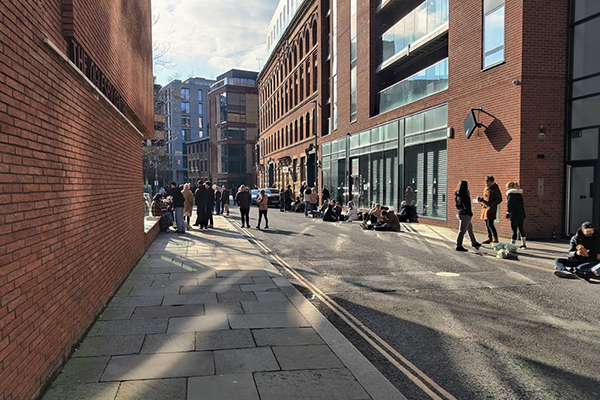Comment
COVID-19 lockdown and the impact on urban living
Joe Piliero in our Design team reflects on living through lockdown as a city centre resident and what impact the pandemic will have on the future of urban living. As an urban designer sharing a one-bedroom flat in central Manchester with his partner, Joe brings an interesting blend of professional insight and lived experience to this subject.
Writing from my confined bedside workspace and reflecting on a year of lockdown in this cramped environment, the strains of living in a dense, grey, hardscape environment are central to my thoughts. An experience shared by many around the globe as the COVID-19 crisis took hold.
Urban living and apartment living has always carried questions over residents’ mental and physical wellbeing; whether it’s about air quality or access to open space there is no question that dense populations bring challenges which detach us from our innate needs. Urban living is undoubtedly a necessary response to population growth with over 50% of the world’s population now living in cities; but the challenge in urban planning pertains to providing these city centre residents with a quality of life one can easily obtain in more rural living.
The urban lifestyle
The average city centre resident lives in an apartment with no private garden, some will have balconies and some will have shared courtyards but access to safe outdoor space away from the threat of viral spread will be extremely limited for most. In a non-pandemic world it has been shown that millennial students or young professionals, who make up the majority of the city centre population, are happy with their choice [1]. We move here to enjoy the vast array of restaurants, leisure and cultural facilities, to take advantage of the best public transport links, and to be within walking distance of our workplaces. We are used to having a multitude of options available to us, and being amongst crowds of fellow residents the moment we step outside of our front door.
With the spread of the COVID-19 pandemic and the closure of businesses these options were suddenly no longer there, and the city dweller now finds themselves house-bound with the majority also without personal transportation. With this new lifestyle came a quick realisation of the basic human needs of space, freedom and nature; all things we quickly realised were almost overwhelmingly lacking.
Green spaces and “Attention Restoration Theory”
A subject long debated in the field of urbanism and planning: how do we enable city dwellers to access green and open spaces in order to improve quality of life? Attention Restoration Theory (ART) (Kaplan, 1989, 1995) suggests that mental fatigue and concentration can be improved by time spent in, or looking at, nature. This would make natural elements a useful asset for those working from home, even the view of nature from a window, Kaplan found, can support micro-restorative experiences. More so than just attention restoration for being productive and active; mental wellbeing must also come into play, and access to green open spaces can play a large role in that.
Small urban green spaces
A study by Nordh et al. [2] assessed the extent to which hardscape, grass, lower ground vegetation, flowering plants, bushes, trees, water, and size predicted the judged possibility for restoration in small urban green spaces. Their findings showed that the greener or more ‘‘natural’’ the outdoor environment, the better it is likely to be for restoration. The size of the space and whether there is grass, bushes and trees were considered to be the most important elements.
The lockdown parks boom
It became apparent just how fundamental natural spaces are for our innate needs immediately after the Prime Minister’s lockdown announcement; at which point a surge of activity in open green spaces suddenly boomed, with police being stretched to disperse crowding. In cities it can be argued that the amenities enjoyed by residents through their bars, restaurants, leisure facilities etc. serve as distractions from the lack of nature found in the urban realm. It is certain that such activities serve as restorative attention methods. With the sudden closure of these amenities, city dwellers like myself were now scrolling Google Maps in vain hope of finding something green where we could take refuge from our cramped apartment, only to be disappointed by unusable or out of reach spaces.

Lessons to take forward
We have learned a great deal over the past year, in what we need to provide to residents living in the places we create as planners, designers, architects and policy-makers. Undoubtedly the case for improving environmental and societal aspects of existing urban environments will continue to grow in demand from residents. Over time we should expect this demand to filter through to more stringent planning policy and we should aim as urban designers and masterplanners to be riding the wave of pursuing greener, more restorative and more sustainable places to live. In the Design team we are constantly challenging ourselves to put public-green-open spaces at the forefront of our designs and use them as the basis of good design. Such spaces should never be an afterthought. We must also challenge ourselves to accomplish this when designing urban regeneration projects in the face of constricted space and high development yield requirements. If cities are to survive as desirable residences for future generations we will need to be creative and always strive for the environmental and social benefits of good design.
For further information please contact Joe Piliero.
12 April 2021
[1] Adam Okulicz-Kozaryn & Rubia R. Valente (2019) No urban malaise for Millennials, Regional Studies, 53:2, 195-205, DOI: 10.1080/00343404.2018.1453130
[2] Nordh, H et al. (2009) Components of small urban parks that predict the possibility for restoration, Urban Forestry & Urban Greening 8